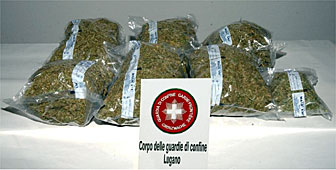
Cooperation key to rise in drug seizures

Better cross-border cooperation has led to a sharp rise in the amount of drugs seized in Switzerland in the first six months of this year, officials say.
Between January and June, Swiss border guards made 29 per cent more drugs seizures compared with the same period last year. The authorities say this increase does not necessarily point to more drug trafficking.
“It’s due to the good job the customs officers and border guards are doing, and the improved cooperation with police and customs authorities abroad, as well as with police in Switzerland,” says Andrea Canonica, a spokesman for the Swiss Customs Administration.
Steps towards Schengen
Switzerland has been seeking to bolster customs cooperation with other countries since late 1998, and this policy now seems to be bearing fruit.
It is also an important precursor for Swiss membership of the Schengen Agreement, the EU accord that removes internal border restrictions while at the same time improving the flow of information between police and customs authorities in member states.
Swiss membership of this zone forms part of the latest batch of bilateral agreements being negotiated by Bern and Brussels. Swiss officials routinely point out, though, that Switzerland would seek to boost customs cooperation with its neighbours, even if it were not seeking to join Schengen.
Staging post
Not only have the number of seizures increased dramatically, but the amount of drugs confiscated is also on the increase, especially heroin and psychotropic “designer drugs” like ecstasy, amphetamines and LSD.
In the first half of this year, border guards seized 64kg of heroin and 92,000 doses of designer drugs. That compares with 50kg of heroin and 20,000 units of psychotropic substances in the whole of 2001.
So far this year, 20kg cocaine, 169kg of cannabis-based products and 660kg of qat – an addictive plant popular in Yemen and the Horn of Africa – have also been seized.
Canonica told swissinfo that much of the heroin seized came via south-eastern Europe – the so-called “Balkan route” – while most of the designer drugs emanated from northern Europe, and in particular the Netherlands.
“There has been a big increase in the amount of ecstasy seized. At the moment most of this is not destined for the Swiss market,” he says, explaining that Switzerland is merely a staging post before export to North America.
However, Switzerland is the final destination for the bulk of the heroin and cocaine entering the country, adds Canonica.
Meanwhile, the number of illegal immigrants stopped at the Swiss border has risen for the first time since 1999. In the first six months of this year, 3,229 people were intercepted, compared to 2,259 in the same period of 2001.
Most of these illegal immigrants tried to enter Switzerland via its western borders, especially Geneva.
by Roy Probert

In compliance with the JTI standards
More: SWI swissinfo.ch certified by the Journalism Trust Initiative




























You can find an overview of ongoing debates with our journalists here . Please join us!
If you want to start a conversation about a topic raised in this article or want to report factual errors, email us at english@swissinfo.ch.